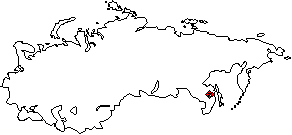CONTENTS
IntroductionForeword
Language Groups
Tribes and Dialects
Order the book
The Peoples
of the Red Book
Abazians (Abaza)Abkhaz
Aguls
Akhvakhs
Aleuts
Altaics
Aliutors
Andis
Archis
Asiatic Eskimos
Bagulals
Baraba Tatars
Bartangs
Bats
Bezhtas
Botlikhs
Budukhs
Central Asian Jews
Chamalals
Chukchis
Chulym Tatars
Crimean Jews
Crimean Tatars
Didos
Dolgans
Enets
Evens
Evenks
Georgian Jews
Godoberis
Hinukhs
Hunzibs
Ingrians
Ishkashmis
Itelmens
Izhorians
Kamas
Karaims
Karatas
Karelians
Kereks
Kets
Khakass
Khants
Khinalugs
Khufis
Khvarshis
Kola Lapps
Koryaks
Kryz
Kurds
Lithuanian Tatars
Livonians
Mansis
Mountain Jews
Nanais
Negidals
Nenets
Nganasans
Nivkhs
Nogays
Orochis
Oroks
Oroshoris
Peoples of the Pamirs
Roshanis
Rutuls
Selkups
Shors
Shughnis
Tabasarans
Talysh
Tats (Tatians)
Tindis
Tofalars
Trukhmens (Turkhmens)
Tsakhurs
Udeghes
Udis
Ulchis
Veps
Votes
Wakhs
Yaghnabis
Yazgulamis
Yukaghirs

THE NEGIDALS
Habitat. The Negidals live on the banks of the River Amgun in the Khabarovsk District and fall into two groups: the Lower Amgun and the Upper Amgun Negidals. Separate families can be found over a much wider area, even among the Oroks on the Sakhalin island. Formerly, Negidal settlements were interplaced with Russian villages along the Amgun.
Population. The census data are as follows:
| native speakers | ||
| 1897 | 423 | |
| 1926 | 426 (683 with the assimilated) | |
| 1959 | 350 | |
| 1970 | 537 | 53.3 % |
| 1979 | 504 | 44.4 % |
| 1989 | 622 | ? |
Anthropologically, the Negidals are representatives of the Mongoloid type, belonging to its Baikal or Paleo-Siberian group along with the Evenks, the Oroks and the Evens.
The Negidal language belongs to the Northern or Tungus Group of the Manchu-Tungus languages. It is kin first and foremost to the Evenki language but also, as seen from certain characteristic features, to the Orochi and Udeghe languages. It divides into the Lower Amgun and the Upper Amgun dialects. There is no written language.
Origin and history. The origin of the Negidals has for a long time been open to debate. Consequently, they have in turns been deemed part of the Evenks, complemented on the Lower Amgun and the Amur with the Nivkh, Nanai and Ulchi elements. A part of the Negidals have at some point merged with the latter. The ethno-cultural development of the Lower Amgun Negidals has been associated with a strong influence from the Nivkhs but it has now been found to contain elements of an ancient non-Nivkh stratum. The infiltration of Tungus features evidently began only later. In the 19th and at the beginning of the 20th century, the Negidal culture displayed typical characteristics of the Evenki forest-culture (hunting, conical tents, clothing, boats made of birch bark, etc.). The Negidals on the upper Amgun bred reindeer after the Evenki pattern, using a part of the animals for riding. The influence of the Lower Amur peoples was evidenced in matters like breeding sledge dogs, using fishskin clothing and the form of the wooden boats. Clothing and methods of construction -- heatable dwellings with plank beds -- displayed a Manchu and Chinese influence. Contacts with the Russians began in the early 17th century (1636 with hetman Perfiliev) but the first attempt to settle Russian Cossacks by the River Amgun was made in 1680. It is from this date that the first written records of the local peoples, the Tungus and the Gilyak, exist (F. Shcherbakov). The term 'Negidal' was first employed in the middle of the 19th century in a treatise by A.Th. von Middendorff and in reports by G. Nevelskoy.
The larger group on the Lower Amgun subsisted by fishing, their mode of life being stationary. Up the river, the importance of fishing declined as hunting took over. Until the end of the 19th century, the Amgun sable was a celebrated article, even on Chinese fur markets. Though the Negidals lived far from the coast they regularly undertook expeditions to the Sea of Okhotsk to hunt for sea animals and birds.
In the late 1920s the Soviet authorities set up national village Soviets in the Negidal habitat and in the 1930s there even existed an Amgun-Negidal District. Around the same time forced collectivization imperiled the small settlements. In some cases salvation from frequent flooding was used as a pretext for resettlements. In 1943, for example, the Negidals of Im were moved to Krasny Yar where they now live among Russians and in 1947 the inhabitants of Ust-Amgun were resettled as far away as the village of Dylma by the Amur. The majority of the Negidals still live on as fishermen and, to a lesser extent, hunters, however, in some places, like Krasny Yar, they have converted to agriculture -- an occupation very rare in the past. All families there now have kitchen plots and many breed livestock. The typical dwelling is a Russian-type log cottage.
The Negidals live in mixed communities shared with Russians where hardly any opportunities for national self-identification exist. Schoolwork is conducted in Russian although there are native teachers as well. Home is the only place that Negidal is spoken. The state of the Negidal language is clearly illustrated by the following data: according to the 1979 census, 48.8 % of the Negidals reported free command of the language and 44.4 % considered it their native language, whereas free command of Russian was reported by 91.7 % and Russian considered the native language by 54 %.
At the Congress of Northern Ethnic Minorities, held March 30--31 in Moscow, the Negidals sent four representatives, hoping for some attention and acknowledgement of their ethnic problems.
REFERENCES
- В. Д. Колесникова, О. А. Константинова, Негидальский язык. -- Языки народов СССР. Т. V, Москва 1968
- К. М, Мыльникова, В. Ю. Зинниус, Материалы по исследованию негидальского языка. -- Тунгусский сборник 1, Москва -- Ленинград 1931
- Негидальцы. -- Народы Сибири, Москва 1956
- А. В. Смоляк, Этнические процессы у народов Нижнего Амура и Сахалина, Москва 1975
IT